How to deal with tomato pests
The larva of the Colorado potato beetle eats two to three centimeters of green leaf per day. The favorite food of these beetles is potato tops. But if there are few potato leaves, then the beetles willingly move on to the tomatoes. Considering that tomatoes have plenty of their own pests, the tomato grower always needs to be on guard.
Let's look at what pests of fruits and plants there are in open ground and what are the methods for treating tomatoes against them. In the article you will find photographs of pests with descriptions of treatment methods.
What happens if you don't get rid of pests?
Are you ready to give part of your harvest to pests? Surely, these were not the goals you pursued when you warmed and illuminated the newly emerged tomato seedlings on dark winter evenings. Leaving everything to chance and not fighting pests is an impractical and dead-end path for those who count on results.
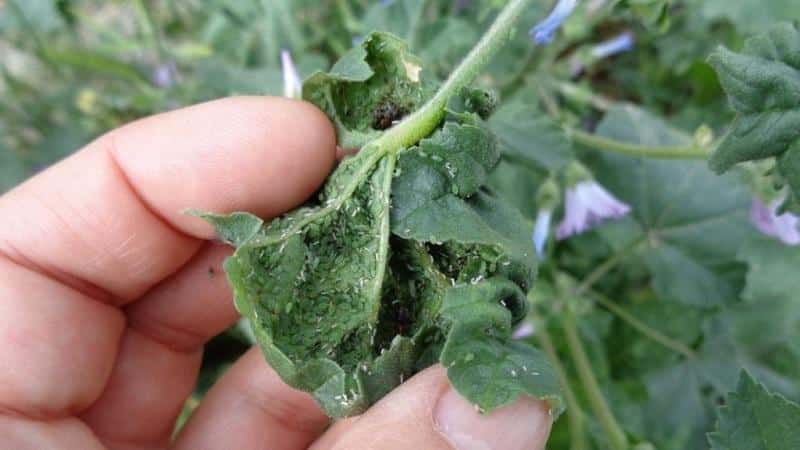
It is imperative to get rid of “saboteurs” in order to:
- the current year's harvest was not affected;
- the soil has not become unusable for planting next season.
What pests are there and how to control them
Let's look at the most common pests of tomatoes in open ground and ways to combat them. The same methods can be used when growing tomatoes in greenhouses.
Whitefly
This is a small midge with white wings. The pest is usually detected when the plant is touched. If you touch a tomato, a flock of white winged insects will fly up. The photo shows whiteflies on tomato leaves.
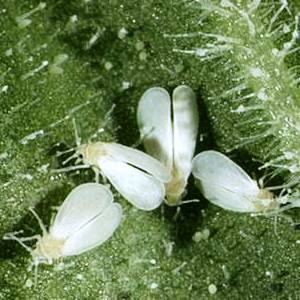
There are other visual signs of the presence of a pest:
- spots on tomato leaves (ranging from whitish to black);
- shiny transparent (like varnish) coating on the sheets;
- leaves curl and wilt.
Whitefly larvae attach to tomato leaves. They stick to the plant and draw juices and nutrients from the leaves.
Enzymes secreted by insects cause the leaves to become covered with a shiny coating.. The plaque contains fungal spores that multiply in the leaf. The leaf changes color: white spots appear, which subsequently turn black.
How to get rid of:
- Using sticky fly strips. The adult whitefly is attracted to the sweet smell that comes from the ribbons. It will stick as soon as it sits on the surface. To save money, it is better to cut the adhesive tape into pieces and insert it into a split stick stuck in the ground between the tomato bushes. After whiteflies adhere, such a tape is burned, and a new fragment is placed in its place. You can make a sticky trap yourself. A sticky mass of castor oil with the addition of honey in arbitrary proportions is spread on a sheet of cardboard. The sheets are laid out on the ground or inserted into a split peg between the plants. Having sat down on such a mass, the pest will get stuck in it and will not be able to fly away.
- Exposure to temperature. Whiteflies, like moths, fly towards the light. Their wings are thin and easily damaged. These features can be used to destroy them. Leave a lit kerosene lamp or regular lamp between the bushes at night. Insects will die from burns on hot glass.
- Using garlic tincture. It is used to combat whitefly larvae and clean leaves from varnish deposits.The recipe is simple: add 150 g of garlic per liter of water and leave for 5 days. If you dilute one tablespoon of this tincture per liter of water, you will get an effective remedy for irrigating tomato leaves and removing sticky plaque.
Important! The treatment is repeated every 3-4 days until the pest completely disappears.
Medvedka
Mole cricket lives in holes in the ground. In appearance it looks like a crayfish or a large legless grasshopper. Here she is in the photo:
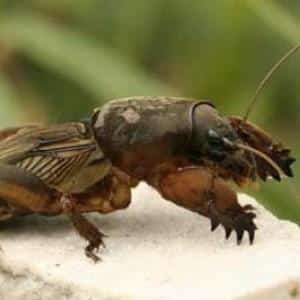 Mole cricket harms all plants, including tomatoes. It digs its passages in the upper layers of the soil, cutting the roots of plants with its claws or gnawing them. Many plants die immediately.
Mole cricket harms all plants, including tomatoes. It digs its passages in the upper layers of the soil, cutting the roots of plants with its claws or gnawing them. Many plants die immediately.
Getting rid of a pest is difficult. Basically, all methods that spare the crop growing on the site come down to mechanical catching of mole cricket individuals. Traps are set to destroy it.
For example, having discovered pest passages in the soil, in the middle of the channel I dig a hole into which a plastic bottle cut to height is placed below the tunnel level. While going through its passages, the mole cricket falls into a trap and can no longer get out of the deep bottle.
Manure pits for catching mole crickets are made in the same way.. The insect is partial to fresh manure and often goes there to settle down for the winter. The pits are reviewed from time to time and the mole crickets are caught.
Gardeners recommend flooding mole cricket habitats with soapy water to catch them (dissolve about 50-60 g of washing powder and 10 g of laundry soap in 10 liters of water). Or use chemical protective agents (for example, Medvegon, Phenoxin Plus, Medvetox according to the manufacturer’s instructions). But then there is a risk of poisoning the tomatoes with toxins.
Bugs and ticks
Not only large pests pose a threat to plants. There are a number almost invisible small bugs and mites that harm tomatoes (see photo of the tick below). Their visually noticeable marks on the plant will help you detect small pests.. Among these traces, the most obvious are cobwebs and changes in the color and structure of the tomato bush.
| Pest type | Features/ Description | Non-chemical control methods |
| Stink bugs
|
If you notice green (sometimes with brown or brown speckles) small bugs with a flat shell on the back on tomatoes, know that this is a stink bug. It feeds on plant sap. Doesn't neglect tomatoes either. After its bites, white-yellow spots remain on the surface of fruits, stems and leaves. | 1. Mechanical collection. Stink bugs crawl slowly on plants. The easiest way to get rid of them is to pick them up with your hands and burn them.
2. Therapeutic spraying:
Thoroughly treat the tomato bushes with the prepared solutions. The procedure is repeated every few days. |
| Rust mite
|
A very small tick. It feeds on the aboveground part of the tomato bush. It sucks juices and can penetrate into the trunk, leaves and fruits. How its activity manifests itself: the leaves begin to curl and may become covered with brown or rusty cracks. | Effective methods of protecting plants from rust mites have not yet been found. Experienced tomato growers primarily recommend preventive methods. Such as:
|
| Spider mite
|
The tick drinks plant sap. It bites mainly through leaves, which begin to become covered with small colorless dots, turn yellow and dry out. Tangles of white threads appear on the tomato, similar to cobwebs. If there are a lot of mites, the leaves dry out and the tomato plant may die. More often than in open ground, spider mites attack tomatoes in a greenhouse.
|
What to use to fight:
|
Attention! Most insecticides are toxic. Considering that tomatoes are grown for food consumption, it is advisable to give preference to natural means of control.
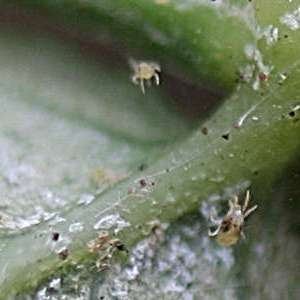
If tomato bushes are heavily damaged by pests and folk remedies are not effective enough, turn to chemicals.
The most effective drugs in the fight against bedbugs and ticks:
- Anti-mite;
- Fitoverm;
- Aktellik;
- Vertimek;
- Karbofos.
For safety reasons, drugs are diluted and dosed strictly according to the manufacturer’s instructions..
Attention! When spraying chemicals, be sure to follow the precautions indicated by the manufacturer on the packaging. As a rule, this means using gloves and a respirator when working with a liquid solution.
Colorado beetle
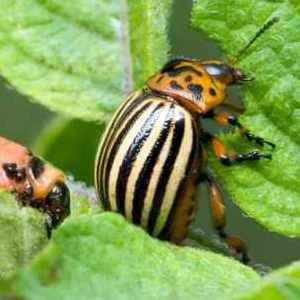 Almost every vegetable grower is familiar with this striped pest.
Almost every vegetable grower is familiar with this striped pest.
Potato bushes suffer the most from the pest, but tomatoes also suffer. Both the beetles themselves and their pink and black speckled larvae can cause damage to tomatoes.. In three weeks, the larvae can easily eat an entire bush.
Folk remedies in the fight against beetles, as practice shows, are not particularly effective. The safest method for tomato bushes is to collect pests from the bushes by hand and destroy them.
Chemistry drugs will help Bankol, Mospilan, Typhoon. Use according to instructions.
Nematode
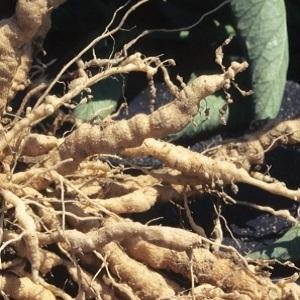
Nematodes are worms that feed on plant juices, including tomatoes.. Worm larvae penetrate the roots of tomatoes through the soil.
Bubbling brown swellings appear on the roots and the roots themselves begin to rise from the soil after 1-2 weeks. Plants wither and stop growing.
If such a disaster happens to your tomatoes, it is better to tear out the infected bushes and burn them. It is recommended to spill boiling water on the soil. This way you can save neighboring tomato bushes from the pest.
For complete destruction, chemical agents are released: For example, Nemagon or Karbofos.
Attention! Plants can only be planted in a chemically treated area next year.
Wireworm
Another a pest that eats potatoes, but does not refuse tomatoes.
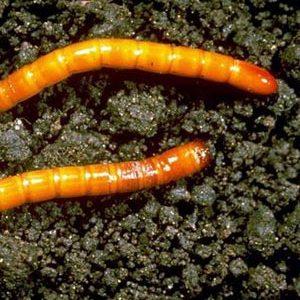
The wireworm eats the roots of tomato bushes. He likes to live in slightly acidic soil, so Liming the soil or incorporating wood ash or ashes into the soil will help fight it. (1 tablespoon per tomato bush).
In the spring, in a plot with tomatoes, you can make wireworm traps: dig 5-6 large potatoes into the ground, which are then dug up along with the wireworm that has bitten into the tubers, and destroyed.
Good results against young wireworms are obtained by irrigating the soil with a strong solution of potassium permanganate before planting tomatoes in the ground.. Recipe: dilute up to 5 grams of crystals per 8-9 liters of water). Solution consumption – 0.5 l per well.
Gnawing owl
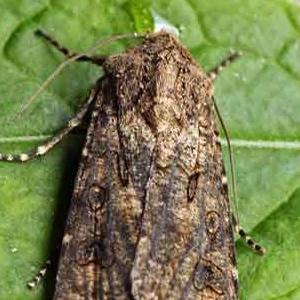 The scoop is a butterfly that looks very similar to a moth..
The scoop is a butterfly that looks very similar to a moth..
The danger to tomatoes is caused by larvae - caterpillars. They chew off the leaves first. And then they switch to tomato fruits.
How to get rid of:
- remove the pest manually;
- spray the bushes with garlic infusion. The infusion is prepared for 3-4 hours by mixing 400 g of chopped garlic and 10 liters of water;
- irrigate the bushes with wormwood solution. 650 g of bitter blue wormwood is brewed with 5 liters of boiling water and kept for 2-3 days. The irrigation solution is prepared by mixing 1 liter of infusion with 9 liters of water.
Aphid
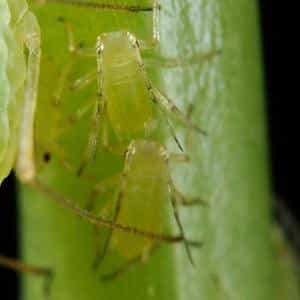 Aphids - destroyer of tender young tomato leaves. This small pest attacks in entire colonies. They suck the juice out of tomatoes, depriving the plant of nutrition.
Aphids - destroyer of tender young tomato leaves. This small pest attacks in entire colonies. They suck the juice out of tomatoes, depriving the plant of nutrition.
The waste products and presence of aphids are detrimental to young greenery. The leaves immediately begin to curl.
The most effective aphid repellents:
- Tobacco tincture. Add 200 g of tobacco mixture to 5 liters of hot water and leave for 24 hours. After filtering, spray the bushes (you can additionally dissolve 100 g of laundry soap for the entire volume of infusion).
- Garlic sprays. Infuse 200 g of garlic in 5 liters of water for several hours. The solution is sprayed onto tomato leaves.
May beetle larva
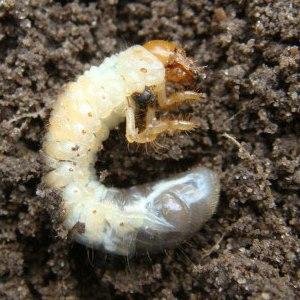 May beetle larvae grow and develop in the ground for 3-4 years. While in the soil, they eat everything they come across, including gnawing the roots of plants, including the roots of tomatoes.
May beetle larvae grow and develop in the ground for 3-4 years. While in the soil, they eat everything they come across, including gnawing the roots of plants, including the roots of tomatoes.
Considering the long development cycle of larvae, spring and autumn tillage gives good results. When digging, the larvae are easy to detect and destroy.
Insecticides acting on larvae: Zemlin, Antikhrushch, Aktara.
Prevention methods
Prevention is easier than treatment. This truth is also true in gardening. If you carry out preventive measures, the likelihood of pest damage to tomatoes will decrease significantly.
How to prevent pests:
- Carry out pre-planting tillage before planting tomatoes. Spill the soil with boiling water or a solution of copper sulfate (take 1 tablespoon of the drug per liter of water). It is advisable to dig the soil deeply throughout the entire area.
- Immediately remove plant debris from the site to avoid the spread of pests.
- Maintain soil crop rotation.
- Select varieties and hybrids of tomatoes for cultivation on the site that are resistant to pests and diseases.
Interesting on the topic:
Secrets of planting and caring for tomatoes
How often to water tomatoes in hot weather to get a good harvest?
What to do when tomatoes grow poorly
How to grow and tie tall tomatoes
How to feed tomatoes during flowering in the greenhouse and fruiting
Let's sum it up
Pest control is necessary to preserve the tomato harvest. There are chemical means of control, and there are natural ones. Considering that tomatoes are intended to be eaten, it is better to avoid the use of chemicals when controlling pests. This is where folk methods and remedies will come to the rescue.
Don't neglect prevention. And then the tomato crops will remain untouched by pests and will completely go to you.